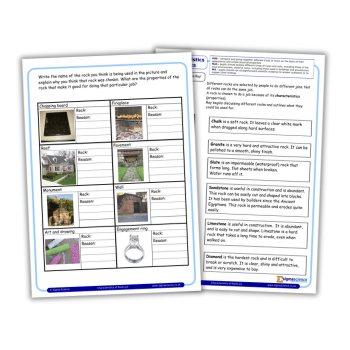This rocks Year 3 worksheet explains that we can use different rocks for different purposes. It shows examples (including images) of:
- chalk – soft and leaves a clear white mark when dragged along hard surfaces
- granite – very hard and can be polished to a smooth, shiny finish
- slate – impermeable and forms long, flat sheets when broken
- sandstone – useful in construction and abundant
- limestone – easy to cut and shape and takes a long time to erode
- diamond – difficult to break or scratch and has a shiny, attractive finish
It discusses their characteristics and typical uses.
The second sheet shows pictures of the following things:
- Chopping board
- Fireplace
- Roof
- Pavement
- Monument
- Wall
- Art and drawing
- Engagement ring
Children need to write which type of rock we might use for the job, and why.
We also have a rocks assessment worksheet with answers, also for Year 3.
Rocks Year 3 curriculum
The primary objectives of teaching about rocks in Year 3 are to develop students’ understanding of Earth materials and to introduce them to basic geological concepts.
Pupils will learn to identify and describe different types of rocks, including sedimentary, igneous and metamorphic rocks. They also explore the properties of rocks, such as their colour, texture and hardness.
Understanding the basic processes involved in the formation of rocks is a key aspect. This involves exploring how sedimentary rocks are formed through the accumulation of layers, igneous rocks from volcanic activity, and metamorphic rocks through heat and pressure.
This worksheet encourages children to compare and classify rocks based on their characteristics, helping them develop skills in scientific observation and classification.
Find out more about Sigma Science at sigmascience.co.uk














